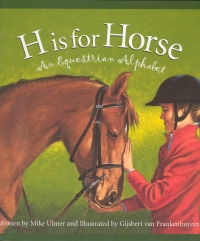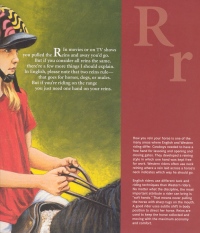| ________________
CM . . .
. Volume XI Number 9 . . . .January 7, 2005
excerpt:
"Here's the question I'm burdened with:
Mike Ulmer, the author of M is for Maple, has done it again with a beautifully illustrated alphabet book that is also an excellent source of information. Each letter has a short verse in a large font, and additional information is presented in two or three short paragraphs in a smaller font. There are facts on breeds of horses, colours of coat, horse equipment, differences in saddles and the difference between Western and English riding. Canada is mentioned in the letter C: "C stands for Canada and the mounted police."
The paintings by Gijsbert van Frankenhuyzen are all unique. On the copyright page, he thanks all the people and their horses for helping him to correctly depict the activities he has painted. The painting on the "F" page shows a farrier putting new shoes on a horse. His toolbox is in the foreground, and beside it is a black and white dog sniffing at the hoof clippings. In his note, he mentions them by name: Jim Cloutier, the farrier, and Elsie, the dog. The paintings show the results of all his research. This book will be an instant hit with all horse lovers! Highly Recommended. Patricia Fay is a teacher-librarian at Beaumont Elementary School in Winnipeg, MB. Her grandfather was a blacksmith who used to bring home the horse hoof clippings for the family dog.
To comment
on this title or this review, send mail to cm@umanitoba.ca.
Copyright © the Manitoba Library Association. Reproduction for personal
use is permitted only if this copyright notice is maintained. Any
other reproduction is prohibited without permission.
NEXT REVIEW |
TABLE OF CONTENTS FOR THIS ISSUE
- January 7, 2005.
AUTHORS |
TITLES |
MEDIA REVIEWS |
PROFILES |
BACK ISSUES |
SEARCH |
CMARCHIVE |
HOME |

 I was interested to learn that there are nine million horses in the United States, 900,000 in Canada and over 60 million worldwide. On the "M" page, where manure and mucking out are mentioned, I also learned that "A horse will 'poo' six to 10 times a day," underlining the importance of keeping the stall clean!
I was interested to learn that there are nine million horses in the United States, 900,000 in Canada and over 60 million worldwide. On the "M" page, where manure and mucking out are mentioned, I also learned that "A horse will 'poo' six to 10 times a day," underlining the importance of keeping the stall clean!